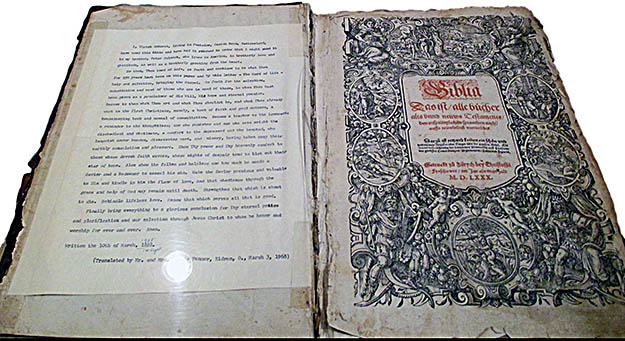
Kindron-Sonnenburg Heritage Center

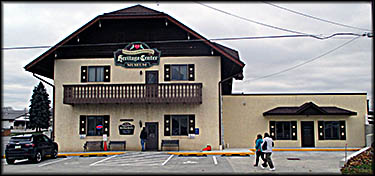
The Museum
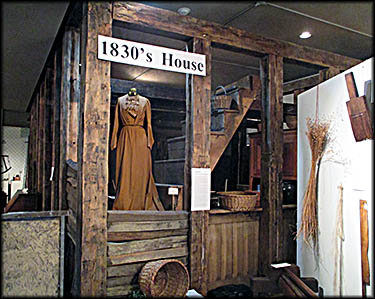

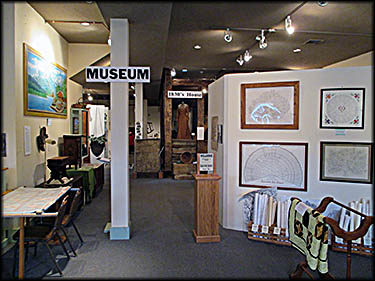
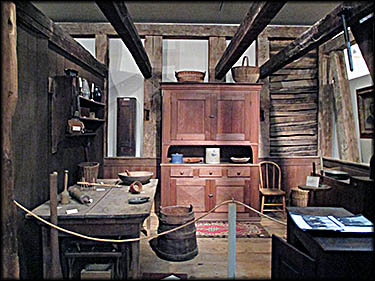
1830s House
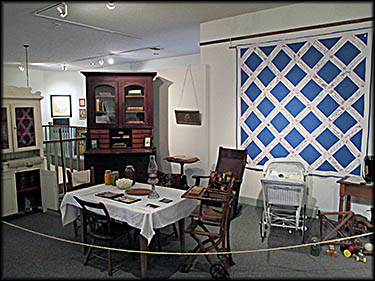
This beautiful Bible once graced the church pulpit in Sonnenberg.
The Kidron-Sonnenberg Heritage Center is housed in a handsome building made to look like a Swiss hotel that contains a remarkable range of historical artifacts from the Kidron, Ohio. About 28 minutes west of Canton, Kidron was originally named Sonnenberg because it reminded its founders of a mountain of the same name in Switzerland’s Jura range from which these Mennonite pioneers had come.
The Mennonite religion came out of the Anabaptist movement in Europe spawned by the Reformation. Founded by Menno Simonszoon, a former Roman Catholic priest born in the Netherlands, the Mennonite religion embraced many Anabaptist tenants, including adult baptism, pacifism, and the separation of church and state. At this time a second baptism in Europe was illegal and punishable by death. Pacifism upset civil authorities because it challenged their ability to conscript men into the military. Monarchs did not like the idea of the separation of church because many were either the head of the state church or had a firm grip on it. Needless to say, authorities did not take kindly to this challenge. The persecution and killing of Anabaptists in general and Mennonites in particular ensued.
The Mennonite religion came out of the Anabaptist movement in Europe spawned by the Reformation. Founded by Menno Simonszoon, a former Roman Catholic priest born in the Netherlands, the Mennonite religion embraced many Anabaptist tenants, including adult baptism, pacifism, and the separation of church and state. At this time a second baptism in Europe was illegal and punishable by death. Pacifism upset civil authorities because it challenged their ability to conscript men into the military. Monarchs did not like the idea of the separation of church because many were either the head of the state church or had a firm grip on it. Needless to say, authorities did not take kindly to this challenge. The persecution and killing of Anabaptists in general and Mennonites in particular ensued.
The Heritage Center’s second floor covers the history of Kidron after 1900. If, for example, you want to know about the origins of Leman’s—a store across the street from the Heritage Center that originally sold hardware but has expanded into much more—this is the place to go. Along two of the upstairs’ walls you will find several quite elaborate graphic family trees on display. While I personally think genealogy is a complete waste of time unless there is nice inheritance at the end, these impressive works of art are worth admiring.
If you are visiting the aforementioned Leman’s in Kidron and the museum is open, I highly suggest you visit. The Heritage Center does have limited hours and isn’t open year round, so check ahead first. Although it costs nothing to get in, I suggest you make a generous donation to this excellent little gem of a museum because this is its primary source of revenue.🕜
If you are visiting the aforementioned Leman’s in Kidron and the museum is open, I highly suggest you visit. The Heritage Center does have limited hours and isn’t open year round, so check ahead first. Although it costs nothing to get in, I suggest you make a generous donation to this excellent little gem of a museum because this is its primary source of revenue.🕜

The twenty-seven people who founded what is now Kidron consisted of, according to one of the museum’s information signs, “three families and two single men.” They started their journey from Switzerland to the United States in April 1819. Once in the latter, they made their way to Ohio and settled in Wayne County. Not surprisingly, living in this untamed wilderness was not easy at first, especially since they had to construct all their buildings from scratch and clear the forest for farming. In time they excelled in many industries and crafts, including cabinet making, basket weaving, metal working, and especially cheese making.
The Heritage Center has grown over the years. Displays have been added upstairs and a new library filled mainly with works useful to genealogists has recently opened. The Heritage Center’s main floor covers the early history of the Sonnenberg settlement, including a house built in the 1830s that was disassembled, then reconstructed inside the museum minus several of its exterior walls. A range of historical artifacts from the old settlement are on display, including a large variety of tools, clocks, and several organs, this last apparently capable of reproducing like rabbits else this author wouldn’t see at least one in just about every local history museum he has ever visited.
The Heritage Center has grown over the years. Displays have been added upstairs and a new library filled mainly with works useful to genealogists has recently opened. The Heritage Center’s main floor covers the early history of the Sonnenberg settlement, including a house built in the 1830s that was disassembled, then reconstructed inside the museum minus several of its exterior walls. A range of historical artifacts from the old settlement are on display, including a large variety of tools, clocks, and several organs, this last apparently capable of reproducing like rabbits else this author wouldn’t see at least one in just about every local history museum he has ever visited.
The Bible that once graced the Sonnenberg Church pulpit is probably the oldest object on display. Printed in 1580 and containing both the Old and New Testaments, it was translated into Swiss German by Huldrych Zwingli and first printed by Christoph Froschauer in 1529. The Bible arrived in America in 1828, sent there sent there from Switzerland by Ulrich Schneck to his brother, Peter. Probably rebound by Ulrich before he sent it, this illustrated Bible is a beautiful work worthy of residence in the world’s most prestigious museums.